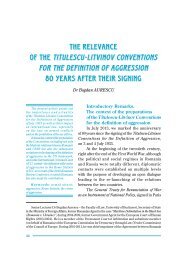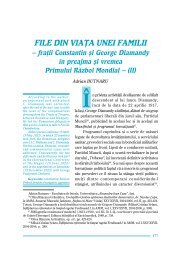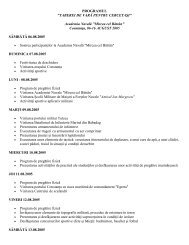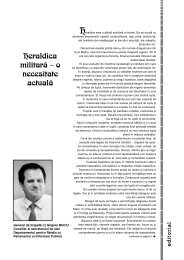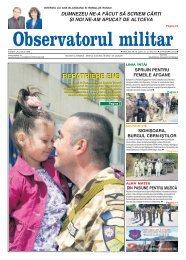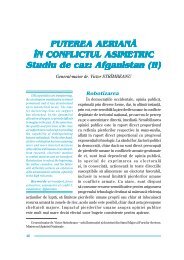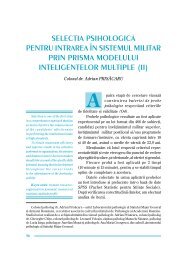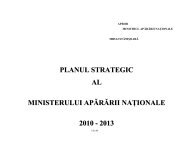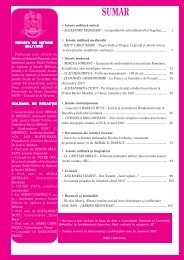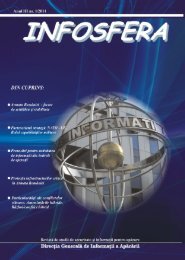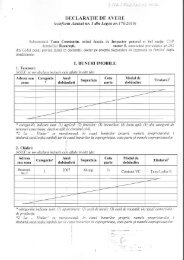Romanian Military Thinking
Romanian Military Thinking
Romanian Military Thinking
Create successful ePaper yourself
Turn your PDF publications into a flip-book with our unique Google optimized e-Paper software.
Opinions • Arguments • Certitudes • Perspectives<br />
and the ones who were responsible for the American doctrine TRADOC concentrated<br />
their effort on solving the issues raised, more or less trenchantly or insidiously, by the<br />
transition from the war of position to the war of manoeuvre;<br />
the concept of “extended battlefield”, supported in the ’70s by William Perry and<br />
then by DARPA (Defence Advanced Research Projects Agency); the long range and high<br />
precision weapons could aim at striking the depth of the Soviet echelons, due to the<br />
technology that allowed for the identification of targets in real time (the Assault-Breaker<br />
doctrine and then the AirLandBattle one); William Perry invented the term of “system<br />
of systems”;<br />
Andrew Marshall and his crew from the Office of Net Assessment make the Soviet<br />
concept “technical-military revolution” an American one, transforming it into the “revolution<br />
of military affairs”;<br />
Admiral Owens, from the Joint Requirement Oversight Council (JROC), and<br />
General Shalikashvili, Chairman of the Joint Chiefs of Staff, support these issues and<br />
try to orient the planning process at the Pentagon to be tailored to the RMA requirements.<br />
At the core of RMA it is the idea of renewing the military operational art. As it has<br />
been noticed, the AirLandBattle doctrine and the Gulf War in 1991, revealed new types<br />
of fight, highlighting the limitations of a period of transition from the classical, massive<br />
strikes to high precision strikes, in the context of battle space info-domination.<br />
Subsequent experience, following the ample actions aimed at bombing the rebel<br />
Serbia, the Taliban in Afghanistan and those in the second campaign in Iraq, the one<br />
between March and April 2003, has brought new arguments for what can be called<br />
the antiwar war. In other words, a power that is technologically superior, which forms<br />
a coalition with other complementary forces, more or less interoperable ones, is capable<br />
of diminishing, discouraging or even preventing any type of war. At least, this is the<br />
consequence of the disproportionality principle. It does not mean that the antiwar war<br />
is necessarily a peace support war, although we can consider such a perspective. In the<br />
meantime, such reasoning is not entirely justifiable and, more important, it is not<br />
confirmed in practice. The experience of the US-led coalition in Iraq and Afghanistan,<br />
and even NATO’s experience, in ISAF Mission, as well as the one of the European Union,<br />
in Artemis, Althea, Concordia and others have shown that the counter or antiwar war is a war<br />
and not something different. According to the report of NATO Parliamentary Assembly,<br />
through the commission specialised in the field, the debate on RMA is held mainly<br />
in the United States. No other country has resorted to such a large debate on the issue<br />
of conduct in the military operations that are to come and it seems no one is preoccupied<br />
with conducting a fundamental analysis of operational concepts. For instance, the United<br />
States spent, in 1996, 37 billion dollars for research and development, while France,<br />
Great Britain, Germany and Italy spent all less than 10 billion. The United States and its<br />
European allies do not have consonant opinions regarding this issue. The Americans<br />
often reproach the Europeans for investing too less in this domain. There is a true gap<br />
between the United States and Europe as far as military technology is concerned,<br />
65



